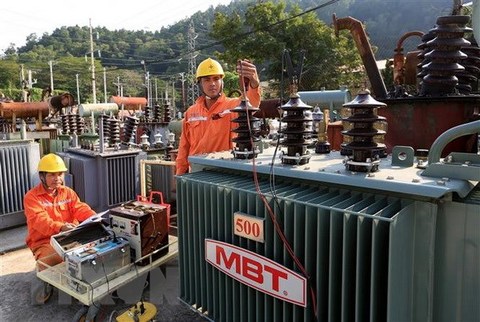 |
| Minister of Industry and Trade Tran Tuan Anh speaks at the meeting – Photo: QDND.VN |
“Vietnam’s electricity consumption would increase by some 8% annually in the 2021-2030 period. The country’s electricity output in 2030 is forecast to reach 138,000 MW, including 27% from coal-fired power, 19% from fossil fuel power, 18% from hydropower, 28% from wind and solar power, 5% from imported power and the remainder from other sources,” he said.
The minister said Vietnam is facing a number of challenges for meeting the demand for electricity. The construction of traditional power plants has met less than 60% of the plan. Meanwhile, renewable energy is developing fast but the underdeveloped power transmission system has prevented it from reaching its full potential.
Besides this, Vietnam is increasingly dependent on imported inputs for electricity production. “It is estimated that the country will need to import 60 million tons of coal and 12 million tons of liquefied natural gas for electricity generation by 2030,” Tuan Anh noted.
Moreover, Vietnam has not introduced sanctions against investors whose electricity projects are lagging behind schedule. The country also lacks special policies for the development of electricity, especially for urgent and exceptionally important projects.
Electricity consumption rises but many electricity projects move at a snail’s pace
According to the Ministry of Industry and Trade, the rapidly developing economy has resulted in the high demand for electricity over the past two decades. Vietnam’s electricity production saw a 10-fold increase from 1990 to 2019.
As of late 2019, the country’s total electricity output from both domestic production and imports reached 239 billion kWh, increasing by 2.35 times compared with 2010.
However, many electricity projects using traditional inputs such as coal or gas and oil, in both the north and the south, are moving at a snail’s pace.
Ten major projects, which were scheduled for completion in the 2016-2020 period, are lagging behind schedule, including the Song Hau 1, Thai Binh 2, Long Phu 1 and the Na Duong 2 projects.
On the other hand, electricity projects using renewable energy, especially solar power, have developed much faster than the planned schedule thanks to the Government’s incentives. From late 2018 until the end of 2019, wind and solar power projects with a combined capacity of 5,000 MW were put into operation.
Industry and Trade Ministry proposes five solutions for the possibility of an electricity shortage
Due to the slow progress of major electricity projects, Vietnam would face a shortage of electricity in the 2021-2025 period, according to the Ministry of Industry and Trade.
The ministry has worked with other ministries and relevant agencies to develop strategies for electricity development and propose special policies for urgent electricity projects.
In addition, the ministry proposed five solutions to ensure sufficient electricity production in the coming years, including putting more wind and solar power projects into operation in the 2021-2025 period, developing more liquefied natural gas-fired power plants, increasing electricity imports from Laos or China, developing the power transmission system and introducing policies that encourage citizens to use electricity efficiently. SGT

Vietnam to face power shortages
Vietnam would face the risk of power shortages from 2021-25 due to slow progress at many large power projects both in the northern and southern...

Power supply is sufficient next year: EVN
Vietnam’s electricity supplier say they are confident they have the power to supply the whole country next year.